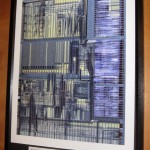Processor Die Photos by Christoph Morlinghaus
I recently had the pleasure of helping noted photographer Christoph Morlinghaus with a die photo project. Christoph takes photos with a large format 8×10 film camera, and wanted to do some of processor dies, so the museum sent him off a box of chips. After a lot of work decapping and cleaning the chips, as well as finding ones with the most interesting dies, Christoph was able to take some stunning shots, no easy feat with the long exposure times required for such a camera. Exposure times for these shots can run into the minutes, and even something as minor as a truck driving by can create enough vibration to ruin the shot. Dies also had to be selected to show a variety of detail, colors, and be big enough to take a picture of, ideally a half inch on a side or better. You can view the results here on Morlinghaus.com. Some very large format prints are currently on display at the Snap! Gallery in Orlando Florida as well.
- Intel i80186 – 1.5u – 55,000 Transistors – 1982
- Intel i486 DX-33 – 1.0u – 1.2 Million Transistors – 1990
- Intel Pentium 120 P54CS – 350nm – 3.3 Million Transistors – 1995
- Motorola MC68020 – 2.25u – 190,000 Transistors – 1982
- Motorola MC68030 – 1.0u – 273,000 Transistors – 1987
- Cyrix MediaGX GXm-200GP – 350nm – 2.4 Million Transistors – 1997
- Cyrix Cx486DX2-V66GP – 650nm – 1.1 Million Transistors – 1994
Christoph did 7 total die shots of a variety of processors spanning 15 years of computing. Dies included are: Intel 186, 486 and Pentium (P54CS), Motorola MC68020 and MC68030 as well as a Cyrix Media GXm and Cx486DX2. A 17″x22″print of each was donated to the CPU Shack, which are now framed and hanging, where they make a very nice display, as well as truly artistic pieces.
Posted in:
Museum News










